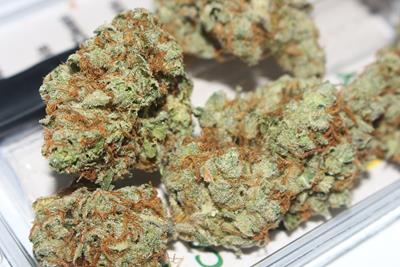
Monday March 25, 2019
 Health/Science
Health/Science
Monoterpenes, polyterpenes, diterpenes, oh my! There are many types of terpenes found throughout the natural world. Like many organic compounds, terpenes are composed of hydrocarbon backbones. Formed by a chain of prenyl diphosphates, which can be easily ionized (or removed), the resulting compounds can undergo a myriad of chemical reactions that allow them to be altered by anything from fatty acids to ketone bodies to alcohol. This is why terpenes have such a large range of applications from a chemical standpoint.
For plants, terpenes are used as a form of biological warfare against insects, or to attract insects to their pollen, depending on their needs. If inoculated with certain fungi, some plants will emit terpenes as an anti-microbial defense against the infection. Does a plant prefer certain animals to propagate its seeds? It’s got a terpene for that. Terpenes emit smell, provide taste, act as lubricants and fuels, and perhaps most importantly to humans, act as medicine through the entourage effect. Hands down though, one of the most remarkable things about terpenes is their ubiquity.
Common Terpenes Found in Nature
To help you understand the sheer magnitude of the occurrence of terpenes naturally, let’s examine a few of the most commonly occurring terpenes in nature.
Limonene
Limonene, you might have guessed, is abundant in citrus fruits. It’s densely packed in the rinds of limes, lemons, grapefruits and oranges. Limonene is also present in many seeds, including dill. In the medicinal realm, it’s used to aid in weight loss, treat bronchitis, and even as a treatment for some cancers. The diversity in pharmaceutical application means limonene infuses into topical ointments, edibles, sprays, and essential oils, for example. Limonene also has unique industrial properties; perfumes and sanitizers use it to enhance their scent and efficacy.

When searching for limonene in in your cannabis, look for anything with the name ‘lemon’ or any cultivar from the Jack Herer line. Unsurprisingly, many skunks are also laced thick with limonene. For the consumer, they will taste the citrus and feel the mood-enhancing effects of this common terpene.
Linalool
Lavender is one of the most beautiful smells on earth. It’s light, enchanting, relaxing and kind. Upon smelling it, a calming sensation comes over one’s body. This phenomenon is partly due to a terpene found in lavender: linalool. It’s a terpene found in mint and cinnamon, but also in some trees and fungi. As a medicine, linalool can be used as a treatment for certain skin conditions, and may contain analgesic and sedative properties. As an industrial tool, linalool is unsurprisingly useful as a fragrance in detergents, soaps, shampoos and lotions. In cannabis, linalool brings a touch of spiciness with a calming, blissful experience. Kosher Kush is a perfect strain for linalool consumption, as are Cinderella 99 and G-13. Each of these cultivars will bring an anxiety-reducing aura, like lavender in your windowsill.
Pinene
Jam-packed into pine trees, pinene has a robust, earthy, unmistakable smell. It smells like Christmas in Michigan. The high density of pinene is used as a form of defense against insect invasion in many species of plants. You’ll find the smell of pinene emitting from the resin of turpentine trees, or you can ingest it by consuming pine nuts. Pinene creates lovely smelling perfumes, acts as a flavoring substance, and, of course, is a main component of turpentine. As an anti-inflammatory, pinene promotes healing and combats asthma. An immune system powerhouse, pinene may also contain anti-microbial and anti-cancer properties.

When consuming pinene through cannabis, a hit of pinene-rich buds delivers a smooth, crisp feel like walking through a dew-covered forest. Blue Dream and Jack Herer both provide a healthy dose of pinene, if you’re looking for a healing and mind-clearing cultivar.
How to Incorporate Terpenes to Improve Your Life
Considering the medicinal, industrial, and well-being benefits that terpenes bring to humans, it makes sense to incorporate them into your daily life. Keeping plants in your home that emit terpenes (lavender, for example) is a great way to ensure that the ecosystem in your home is full of healthy compounds. Incense can increase the aura and density of terpenes in the air, while using terpene-rich lotions facilitates the tactile benefits of terpenes through absorption by the skin. Eating foods flush with terpenes brings them to the gut where they can encourage a healthy gut-biome. Even taking a walk through the woods will expose you to terpenes in a way that is beneficial to your health. There are literally a plethora of ways to bring terpenes to your life.
A Perfect Mix: Terpenes and Cannabis
Every type of flower you’ll find in your local dispensary is full of terpenes. The only question is: which ones? Every cultivar has a unique terpene and cannabinoid profile. Some are rich in THC with a diverse terpene profile, others are high in CBD and heavy in pinene.
Since there is such a diversity between the way cannabis affects each person, people will have their own unique reaction to terpenes, making it important to be cognizant of the cultivar you are consuming.
Ensuring you are receiving the correct chemical profile means you’ll be able to reach the intention you set out with when you consume your cannabis. With all the benefits that humans find in terpenes, it’s no surprise that some people consider them to be a gift from nature. Though they are found in many different plants and flowers, the complex terpene profiles in marijuana strains are a testament to the healing power of the plant, as well as its generosity and loving nature.
Did you know that cannabis is an extremely nurturing plant? What benefits have you found from using it in your life? Share your experiences in the comments below!
Photo Credit: Bruna Branco (license)







